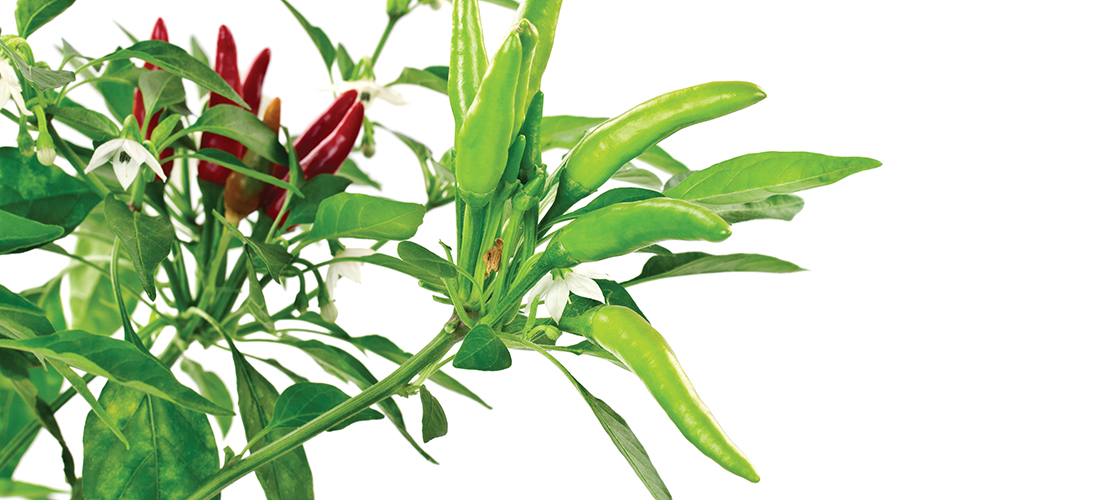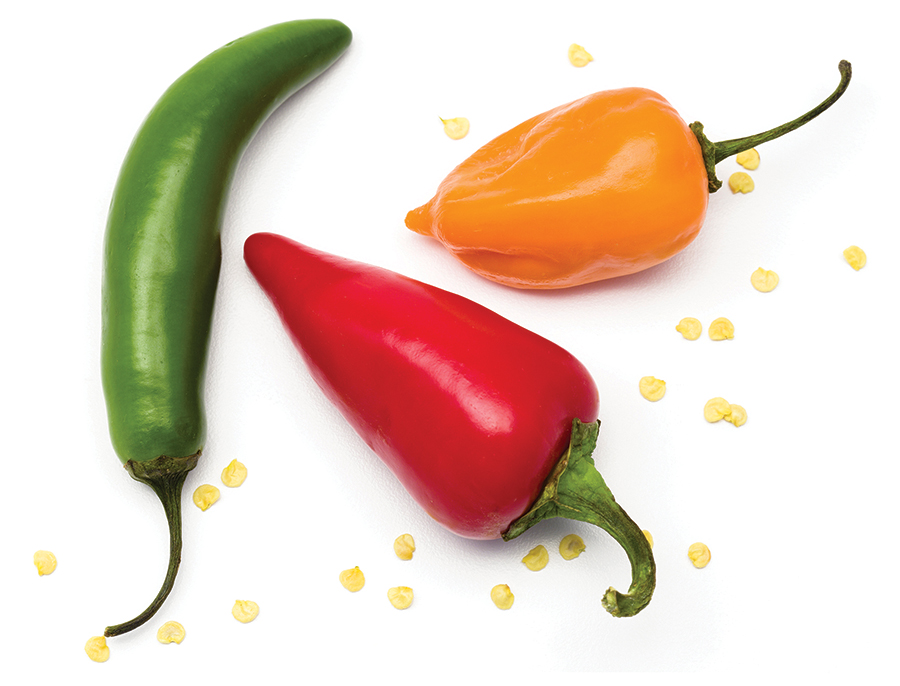
Pick a Peck of
Peppers
From heat to sweet, there’s something for every palate
By Ross Howell Jr.
Now that the azaleas are blooming, what better way for gardeners to dream of summer’s bounty than by thumbing through seed catalogs or browsing the internet?
I was searching for hot peppers. A friend told me she loved eating ghost pepper jam — though it made her sweat.
I hadn’t thought about eating one. I just liked the name.
You know the internet. Soon, I was reading how the ghost pepper was supplanted as the world’s hottest chili pepper by the Trinidad Scorpion Butch T, which was supplanted by the Carolina Reaper, a pepper grown next door in the Palmetto State.

I can’t eat hot peppers. But I like growing them. However, I grew up eating peppers my mother harvested from her garden. Sweet, elegantly green bell peppers.
Turns out I found a kindred spirit.
Julie Hale is the community garden coordinator for Greensboro Parks and Recreation.
“I can’t eat the hot ones, either,” Hale says. “But I like growing them because they’re so beautiful.”
Last summer in Keeley Park Community Garden, she ran a program called One Hot Summer.
“The idea was that we’d teach hot pepper growing and eating,” Hale says. She spent weeks researching the 13 varieties she’d try in the garden demonstration bed. She also developed a field guide for the plants.
The guide includes color pictures, growing times to maturity, what to expect in terms of size and shape, and how hot peppers can be used in food.
“It was important to select varieties that weren’t too hot,” Hale says. “Some people just don’t like much heat or can have a bad reaction.”
In addition to seeing the demonstration bed, participants also could take free plants home to try in their gardens.
“The Jaloro Jalapeño is a variety we shared with folks who signed up for our program,” Hale says. She chose the Jaloro — developed at Texas A&M University — because of its mild flavor. Its yellow color is also unusual.
“Most people think jalapeños are only green in color,” she adds. Since the Jaloro is small, it could be grown in a container if people didn’t have garden space.
Best of all?
“It’s very productive,” Hale says. “We had lots of extra peppers we donated to the food bank.”
Another big producer is the Aji Dulce Spice Pepper, an heirloom originating in Venezuela.
“One of my favorites,” Hale adds. “The plants were covered with peppers all season.” She also recommends the Dulce’s small, thin-walled fruit that offers just a hint of heat. “Great to dry and grind for spice,” she concludes.
Another standout was the Czechoslovakian Black Hot Pepper, which is highly ornamental, with white-streaked, lavender flowers and purple-green leaves.
“With beautiful purple-black fruits, ripening to red,” Hale says, “it was the most commented-on variety in our demonstration.”
Another star pepper was the Mad Hatter, developed from a variety called Bishop’s Crown.
“Featuring spaceship-shaped fruit and minimal heat, this pepper also got a lot of comments,” Hale says. It was voted “very delicious” by official taste-testers at the garden.
Other hot peppers Hale grew were Sally’s Hot, Xochiteco Hot Pepper, Grenada Seasoning Spice Pepper, Carolina Cayenne, Aji Chinchi Amarillo, Baron Poblano, Jasmine Rissie, Hungarian Paprika Spice Pepper and Biquinho Yellow.
And for folks like me, who can’t abide spicy heat, Hale had the Ashe County Pimento. Cultivated in the Appalachian Mountains near Boone, it’s an heirloom sweet pepper with a flattened bell shape.
“Delicious when fully ripe,” she adds.
Hale grew most of the pepper varieties from seed. She recommends Southern Exposure Seed Exchange (SouthernExposure.com) in Virginia and Johnny’s Selected Seeds (JohnnySeeds.com) in Maine.
Summer is a day nearer. OH
Freelance writer Ross Howell Jr. asks that you put this Parks and Recreation program on your garden calendar: “Intro to Backyard Composting,” Thursday, May 12, 6–8 p.m., Keeley Park Community Garden. Call Julie Hale, 336.373.4549.





